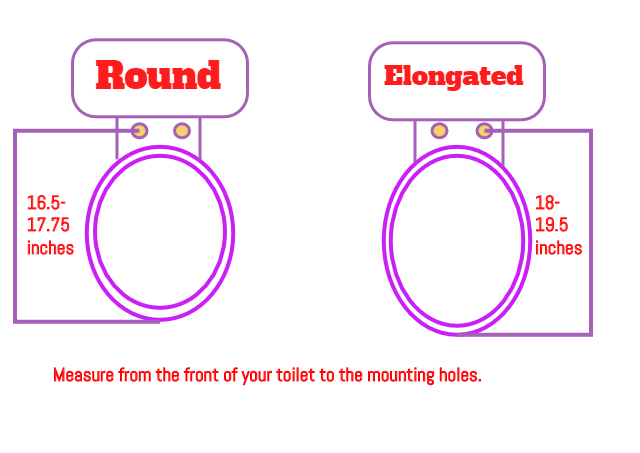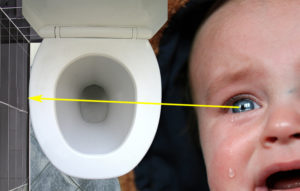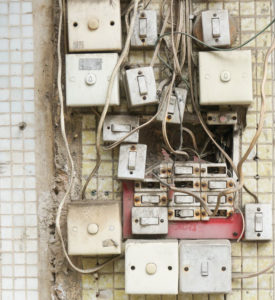Buying a bidet is a transcendent experience, so it isn’t surprising that many people rush into the process and buy the first bidet that looks sexy enough to clean their undercarriage. Without careful research and due diligence, the bidet buying process can turn from a dream into a shitty experience. To help you avoid snags, snafus and outright disaster, pay particular attention to these ___ factors while you’re searching for your new best friend
1. Elongated or round?
(If you’re planning on getting a bidet attachment, read on – this doesn’t apply to you. Hooray!)
Most toilets nowadays have one of two types of bowls: round or elongated, with elongated being more common. Therefore, most bidet manufacturers have made corresponding bidets to fit both kinds. Some bidets only come in one size or the other, however, so be sure you’re buying the right one.
How do you determine the shape of your toilet? Well, start with looking at it from a birds’ eye view. If the bowl appears to have a soccer-ball shape, then it’s round. If it looks more like a rugby or football ball, then you’ve got yourself an elongated. You can also bust out your measuring tape and measure from the front of the toilet to the seat mounting holes. An elongated toilet will measure from 18 to 19.5 inches whereas a round toilet will measure 16.5 to 17.75 inches.
This might seem obvious, but it’s an easy mistake to make!
2. Do you have room?
Bidets aren’t massive devices, but they do increase the footprint of your toilet by a couple of inches. This can be especially irksome if the left side (while you’re facing it) of the toilet is close to or against a wall or cabinet. Toilets in this position can really only manage with a remote operated bidet-seat. All bidet attachments are out, as are all panel operated bidet-seats. I don’t know of any bidets that currently feature a panel on the right side of the bidet, so, sorry lefties!

Beware the position of your throne.
I mentioned remote operated bidet-seats as a solution to this issue, and it is worth talking a little more about. Remote operated bidets will come with a remote as well as a mountable remote-holder.
Some benefits of this compared to a panel operated bidet-seat are: solving the issue of not having enough clearance for a panel, easier operation (no reaching back to press some of the buttons that are located near the rear of the panel), much better for lefties, streamlines the look of the toilet.
To sum it all up: measure the clearance between the right side of the toilet and the wall/cabinet/obstruction and consider getting a remote operated bidet-seat if there isn’t enough room.
3. You will NEED a power outlet for electric bidet-seats (and bonus warning for bidet attachment people).
Another seemingly no-brainer, but another detail that can often get overlooked in the excitement of buying a bidet.

Don’t let this happen to your bathroom. Be aware of your electrical outlet situation.
If you’re buying a bidet-seat, chances are, it’s electric. The nozzle, water and seat heaters, dryer, and everything else requires electricity – and therefore a working three pronged outlet (or adapter) in order to function. Before ordering a bidet-seat, take a peek at your commode. Where is the power outlet? Is it conveniently located next to the toilet? If not, is the cord running from the bidet-seat to the available outlet not too much of an eyesore? Are there other appliances that need to be plugged in at all times that are going to hog the outlets? Will you have to annoyingly unplug one device to plug in your bidet and vice-versa?
These are some questions that need to be asked before you decide a bidet-seat is a good fit for your bathroom.
Bidet-attachment buyers, beware! You aren’t totally off the hook here. If you’re buying a bidet-attachment with a warm water option, you need to be sure your bathroom has a warm water connection that you can easily access. Is the warm water attachment in a cabinet under the sink? Are you willing to drill a hole in the cabinet to thread it through? Again, are you going to be okay with the look of your bathroom after connecting the hot water to your bidet attachment?
4. Tankless or reservoir heating?
Electric bidets typically have one of two heating methods. Tankless heating will instantly heat water and can provide a limitless supply of warm, butt-friendly water. Bidets that feature this method of heating will be smaller (more on why later) and more expensive. Who doesn’t want an unlimited stream of gloriously comfortable water to the sphincter?

Reservoir heating systems employ a large tank (this is why tankless are smaller!) to hold and heat water. The bidet will fill the tank with water and heat it up, then continue to heat it periodically when it’s not in use so that you aren’t left getting an unpleasant, ass-clenchingly cold jolt when you clean yourself. The problem with these types of bidets is that the hot water will eventually run out. It can usually suffice for a single user, but if you’ve got a line forming outside the bathroom of all the neighbors who’ve heard your yells of ecstasy during your cleaning sessions (….or just family members or roommates), then the next user might not be too pleased with the lack of warmth.
5. Do you need feminine cleansing?

If you’re a lady, or have ladies in the household, the answer to the above question is an emphatic YES! Feminine cleansing boils down to either a second nozzle or a movable nozzle which is capable of cleaning the frontal area, instead of the rear. For men, this is pretty pointless, although it’s not a totally terrible experience.
Nearly all electric bidet-seats will have this feature, so no worries there. But, be on the lookout for bidet attachments that only have one, immovable nozzle. If you’re looking for the best in hygiene, a frontal cleanse is a must.
In the end, a bidet can only give you as much bang for your buck as you allow. Be smart about buying a bidet and don’t forget these five essential points to keep in mind. Happy bideting!